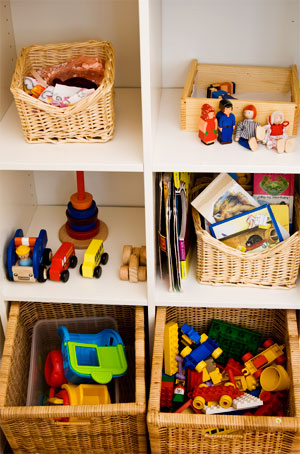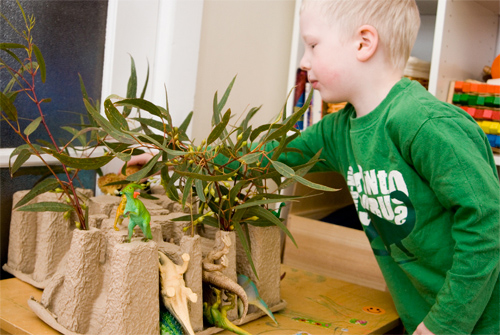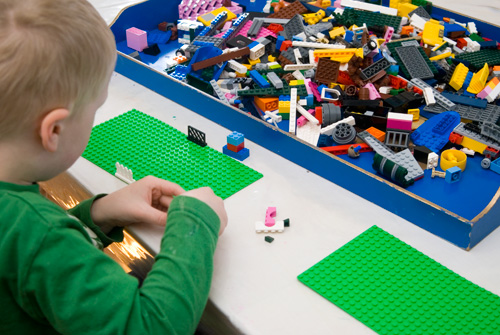Managing Play With Children of Different Ages
This post is by regular contributor Kate Fairlie of Picklebums.
We have four kids – seven year old twin girls, a four year old boy and a one year old boy. Sometimes finding the space or suitable activities for everyone to play together can be a bit tricky. Sometimes there is frustration and tears, but mostly we find ways for everyone to do what they need to do without upsetting anyone else!
Here are my tips, tricks and ideas for play and activities with children of multiple ages.
Set Up For Success
Try to set up your living areas so that children can be successful and independent. Think about the developmental stages of your children and set up the environment so that you can say yes more often than you say no.
If you can remove (out of sight, not just out of reach) objects that you don’t want played with. We’ve not had a coffee table in our living room for the past 6 years. It was easier to go without the coffee table than rescue the baby who’d climbed up there or shout at the preschooler who liked to leap off it.
Store toys in ways that are easy for all children to access and to put away. Baskets or containers on open shelves work well. Put toys more suitable for little ones down low and those for older kids up high, out of the baby’s reach.
Setting up your environment for success will mean your children are more able to play independently for longer, and will help them play together (or alongside each other) with less arguments and frustrations.
Choose Toys Wisely
Choose toys that can be used in a variety of ways by children of different ages. Remember that older kids still enjoy the basics and the right toys will never be grown out of.
Open-ended toys such as wooden blocks, Duplo, animal figurines, home play items, etc. can all be enjoyed by children of all ages in lots of different ways. Even our seven year-olds still love playing with blocks and will create complex constructions, while the preschooler loves to build tall towers and the baby loves to knock them down or simply put the blocks in and out of various containers.
Set up a play scene or simple activity to engage one child while you do something special with the other(s). Opening the door to the plastics cupboard will interest my smallest for a while so I can build Lego with his big brother. A play scene with sand, leaves and dinosaurs will keep the preschooler happy for hours leaving me free to play with the baby.
Divide and Conquer
Sometimes activities that aren’t safe for the baby, or that need lots of supervision, are best done somewhere or sometime when he is not around.
There are some activities that I simply can’t manage when my attention is split between too many things, so we use the baby’s afternoon nap to do complex activities that require lots of my attention, assistance or supervision.
We also wait till there are two adults on hand to do some more grown-up activities that would bore our preschooler and end in disruption and frustration. It’s best to read that long and tricky book after he is in bed, or do that special art activity when the preschooler and baby can hang out with Daddy.
Activities that don’t need my constant attention but are not baby friendly, are set up in places that the baby can’t access. He has not yet mastered climbing onto the dining chairs so often the bigger kids will take what are usually ‘floor toys’ up onto the table. Blocks and floor puzzles are safely out of reach from ‘The Wrecker’ so they can play unhindered.
The same works for toys with small pieces, art activities, or any activity where our smallest might eat the equipment.
We use a big tray with sides to help keep tiny pieces like Lego or beads from getting lost on the floor and in the baby’s mouth. The big kids know to be vigilant, and make sure any dropped pieces are quickly rescued before they are swallowed.
You could also use an old fashioned play pen. Not for the baby, as they would quickly get bored and frustrated in such a confined space, but pop the bigger kids and their activity in there to keep them out of the way.
It’s not just important to keep the baby safe but also to allow the big kids space and time without the smallest family member wrecking everything. It also saves my sanity so I can go about my work, while they play, without worry.
Adult Interaction
Learning to play together, share and get along is not easy, even when everyone is at a similar stage of development. It is even harder when there are combinations of ages. It is a big ask to expect even a school aged child to always understand and accommodate the needs of younger children.
Supporting your children’s play by supervising and stepping in when frustrations occur will help everyone play together. Explain the needs of younger children and how older children can accommodate them within their play. But don’t expect older children to always give up their toys, or change their activities for younger children, that’s not fair and does not build positive relationships.
Support younger children while they play, especially if they are taking part in an activity that might be a little tricky for them. With a little supervision, timely support, and perhaps some simple modifications, young children can feel successful doing more complex activities.
And lastly, have realistic expectations. Depending on the ages and stages of your children, it is not always going to be possible to include all of your children in all things all the time. Sometimes you have to let go of the idea that your children will play perfectly together all the time, or that you will be able to do complex activities. Sometimes you have to accept the joyful chaos that is siblings and bide your time… eventually, when everyone is a little older, there will be time for that amazing play idea.
What are your tips for managing play time with children of different ages?
Be sure to check out Kate’s follow up post – Managing Kids Art with Children of Different Ages.




I loved the idea of gating off an area for the big kids. One of my fav blogs turned a closet in their tiny closet into such a space.
http://carfreecambridge.com/2010/08/beating-toy-clutte/
Oh that is a fabulous idea!! Wish we had closets now! Thanks for sharing!
Fantastic post! I’ve just had a a baby and I needed some ideas to keep the rest of the kids content whilst I’m feeding her, or taking care of her.
When I’ve had toddlers and a baby (or even bigger kids and a baby) I’ve found having a special ‘busy box’ with all kinds of little interesting items in it that only comes out when you feed the baby helps a lot. A friend made some up for our twins when our middle child was born with things like stickers and a notebook, little plastic animals, pipe cleaners… things like that.
Oh yay, a sensible mother getting it all sorted, well doen Mrs Picklebums. I have 4 children too, twins in the middle & the youngest is 7.5 years old. It’s amazing how the younger children go with the flow & if the older ones have beautiful sharing & independent play skills, how the babies just pick up that it’s the only way to roll, then you get happily included in all the activities. Love Posie
I agree open ended toys are the best. I have a 2 and 4 year old and they play together most of the time. Sometimes with adult support and sometimes without. They play outside, picking flowers and making “soups”, with duplo, blocks, etc and with cubbies and dolls ALOT. They play at their own level and the little one learns lots from her older sister. Most art activities, I provide the materials and support and they use them in their own way. Miss 4 is currently obsessed with playing eye spy. We have helped her to accept that Miss 2 doesn’t really know what letter words start with so we just let her have her turn in her own way and we carry on. So we get lots of “I spy something that starts with t” “Its a house!” Miss 4 just rolls her eyes, explains that house starts with “H” and moves on!!!
Hi, this is a great post. I have three children ages 1, 4 and 12 so we deal with these issues a lot. I posted this to my facebook page. 🙂
This is a great topic. I have a 6-month old and a 3-year old, and I am worried about the impending mobility of the former child. My other problem is that neither child will play alone, so I am always trying to manage the needs of both, and of course, that is a hopeless endeavor. Actually, the 6-month old is better at independent play. The older child is–like many children–fascinated by dinosaurs. I have dinosaur figures, puzzles, books, little homes made of cardboard boxes for the creatures, playdoh (for stomping and footprint making), paint (again for stomping dinosaur feet into), you name it we have it or we’ve done it (and, of course, we have regular non-dinosaur toys too), but everything is always “Play with me, Mommy!” So, even when I set the older child up on a table with her little creatures, I am “forbidden” from either doing housework or playing with her younger sister. It’s either “Play with me! Play with mmmeeeeeee! Moooommmyyy!!!!” or “No, stop doing that with [the baby]! We are not playing that game right now.” I am making her out to be a tyrant. She’s really very sweet and affectionate, but she won’t play alone.
It can be so hard to find yourself stretched between more than one child, not to mention all the other things you need to do, let alone those things you want to do.
I think sometimes our kids just really need is to be there, beside them, a lot!
My kids are all pretty good at independent play but they sometimes go through patches where they want me all the time. I find it is easier to go with the flow on these occasions, but I don’t usually sit and do nothing but play, I usually find a way to work along side my kids. They might be playing with play dough at one end of the table while I fold laundry at the other. I am right there with them, and I can help out when asked, but I am also getting on with my work while they get on with theirs.
Inviting my kids to come and help me with my work also helps at times. If you are doing things in the kitchen how about putting a little water in the bottom of the sink, tossing in the dinosaurs and lettering her play while you make dinner next to her?
Hope that helps a little.
Thank you for helping me with this problem. My husband and I are going to rearrange our play spaces this weekend–based primarily on your advice above. As to playing independently, I guess my daughter has to be super passionate about the activity to do it herself–we made a moonlit dinosaur box this weekend together, and she hasn’t touched it once since. I have gotten out the watercolors, the blocks, the legos, the figurines, the dinosaur stickers, everything to see if she could sustain any interest without me. We went to the acquarium together on Monday, and I asked her to draw me a picture of her day, and she said she couldn’t do it without me. I did follow your suggestion about the dinosaurs in a bucket of water, and it was brilliant–I actually got a ton of dishes washed, and she was thrilled–but my husband came in and freaked out, because there was water everywhere (apparently, the T-Rex needed some puddles to jump in), there was dish soap on the microwave, the Brita filter, and our pepper grinder (all hopping off places for the dinosaur’s adventures), and all of our garlic has been put into the soapy mess along with the dinosaurs. I thought it was great, but he started yelling about the mess, she started crying, and all was lost.
🙁
oh Jennifer it can be so hard to balance everything sometimes can’t it!
Don’t give up… I promise things will get easier as your little ones grow!
Wonderful Post and thanks for the ideas… Now I know how to keep the little angel in our family busy 🙂 thanks again
A huge thank you for this post! This is one of my biggest struggles right now – I’ve got a 3 1/2 year old son and a 15 month old daughter. My son is, thankfully, great about playing independently, but my daughter is still in that stage of putting everything in her mouth and not really yet into “toys.” Please, please, please keep more posts like this coming!
Hi Kate –
Great post and wonderful suggestions! I am putting a link in the September 6 issue of Parenting News, our free weekly newsletter for parents and teachers. I hope it brings you many new readers and visitors to Picklebums and Childhood 101.
All the best –
Maggie Macaulay, MS Ed
http://www.WholeHeartedParenting.com
Does anyone recommend a book anyone about on how to play and what games/toys to play with at different ages?